
Concept explainers
How many absorptions would you expect to observe in the 13C NMR spectra of the following compounds?
(a) 1,1-Dimethylcyclohexane
(b) CH3CH2OCH3
(c) tert-Butylcyclohexane
(d) 3-Methyl-l-pentyne
(e) cis-1,2-Dimethylcyclohexane
(f) Cyclohexanone
a)
Interpretation:
The structure of an given molecular formula C8H16 to be predicted using 13CNMR spectra.
Concept introduction:
The 13CNMR spectrum gives information on the different electronic environments of carbon. As like 1HNMR, the number of signals generated in 13CNMR are predicted by performing symmetry operations (rotation or reflection symmetry). Only chemical shift values are reported in the spectrum but not the multiplicity and integration values because the coupling between two neighboring 13C - 13C nuclei are weakly involved due to the low abundance of 13C isotopes of carbon atom.
Broadband-decoupled 13CNMR spectrum: The spectra provide information regarding the total number of carbon environments.
DEPT (Distortionless enhancement by polarization transfer):
i) DEPT -90: The spectrum exhibits signal only from CH group and no signals from CH3, CH2, CH and quaternary carbon (carbon with no protons).
ii) DEPT -135: The spectrum exhibits CH3 groups and CH groups as positive signals (pointing up); CH2 groups appear as negative signals (pointing down) and quaternary carbon does not appear.
The signals appear in each type of spectrum:

To identify:
The structure of given molecular formula C8H16.
Answer to Problem 47AP
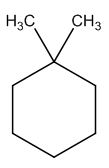
Explanation of Solution
Calculate HDI value:
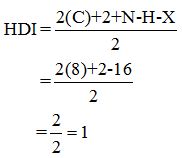
The HDI calculation led to confirm about the presence of a double bond or a ring.
Interpret the given 13CNMR spectrum:
Broadband - decoupled spectrum:
The spectrum shows five signals whereas the given molecular formula also has eight carbon atoms. Thus all the eight carbons have chemically different electronic environments showing signals.
i) The five signals in the region of 0-50ppm indicate the sp3 hybridized carbon atoms which can be methyl / methylene or Methine groups.
DEPT -90: Spectrum has no signals led to confirmation of no CH group in the structure.
DEPT -135 (gives signals of CH2, CH3 and C groups):
ii) The two positive signals indicate the presence of two methyl groups as no signals appear in the DEPT -90 spectrum.
iii) The three negative signals indicate the presence of four methylene groups; only methylene groups appear negative in the spectrum.
iv) So far the group of fragments obtained is
Two -CH3, -C-, four -CH2
From the fragments (CH3 + CH3 + (CH2)5 + C = 16 protons) sixteen protons are obtained whereas the total number of protons from the molecular formula is also sixteen.
The possible structures are:

The first structure possesses rotational symmetry and exhibits fewer signals in the spectrum and gets cancelled out.

The structure of a given molecular formula C8H16 is predicted using 13CNMR spectra.
b)
Interpretation:
The structure of an given molecular formula C8H16 to be predicted using 13CNMR spectra.
Concept introduction:
The 13CNMR spectrum gives information on the different electronic environments of carbon. As like 1HNMR, the number of signals generated in 13CNMR are predicted by performing symmetry operations (rotation or reflection symmetry). Only chemical shift values are reported in the spectrum but not the multiplicity and integration values because the coupling between two neighboring 13C - 13C nuclei are weakly involved due to the low abundance of 13C isotopes of carbon atom.
Broadband-decoupled 13CNMR spectrum: The spectra provide information regarding the total number of carbon environments.
DEPT (Distortionless enhancement by polarization transfer):
i) DEPT -90: The spectrum exhibits signal only from CH group and no signals from CH3, CH2, CH and quaternary carbon (carbon with no protons).
ii) DEPT -135: The spectrum exhibits CH3 groups and CH groups as positive signals (pointing up); CH2 groups appear as negative signals (pointing down) and quaternary carbon does not appear.
The signals appear in each type of spectrum:

To identify:
The structure of given molecular formula C3H8O.
Answer to Problem 47AP

Explanation of Solution
Calculate HDI:
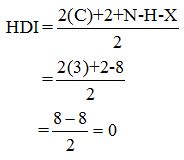
The HDI calculation led to confirm about the absence of a double bond or a ring.
Interpret the given 13CNMR spectrum:
Broadband - decoupled spectrum:
The spectrum shows three signals whereas the given molecular formula also has three carbon atoms. Thus all the three carbons have chemically different electronic environments showing signals.
i) The five signals in the region of 0-50ppm indicate the sp3 hybridized carbon atoms which can be methyl / methylene groups.
DEPT -90: Spectrum has no signals led to confirmation of no CH group in the structure.
DEPT -135 (gives signals of CH2, CH3 groups):
ii) The two positive signals indicate the presence of two methyl groups as no signals appear in the DEPT -90 spectrum.
iii) The spectrum shows three signals whereas the given molecular formula also has three carbon atoms. Thus all the three carbons have chemically different electronic environments showing signals.
iv) So far the group of fragments obtained is
Two -CH3, -CH2
From the fragments (CH3 + CH3 + CH2 = 8 protons) eight protons are obtained whereas the total number of protons from the molecular formula is also eight.
The structure of a given molecular formula C3H8O is predicted using 13CNMR spectra.
c)
Interpretation:
The structure of an given molecular formula C8H16 to be predicted using 13CNMR spectra.
Concept introduction:
The 13CNMR spectrum gives information on the different electronic environments of carbon. As like 1HNMR, the number of signals generated in 13CNMR are predicted by performing symmetry operations (rotation or reflection symmetry). Only chemical shift values are reported in the spectrum but not the multiplicity and integration values because the coupling between two neighboring 13C - 13C nuclei are weakly involved due to the low abundance of 13C isotopes of carbon atom.
Broadband-decoupled 13CNMR spectrum: The spectra provide information regarding the total number of carbon environments.
DEPT (Distortionless enhancement by polarization transfer):
i) DEPT -90: The spectrum exhibits signal only from CH group and no signals from CH3, CH2, CH and quaternary carbon (carbon with no protons).
ii) DEPT -135: The spectrum exhibits CH3 groups and CH groups as positive signals (pointing up); CH2 groups appear as negative signals (pointing down) and quaternary carbon does not appear.
The signals appear in each type of spectrum:

To identify:
The structure of given molecular formula C10H20.
Answer to Problem 47AP
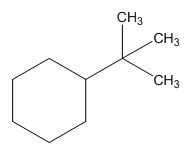
Explanation of Solution
Calculate HDI:
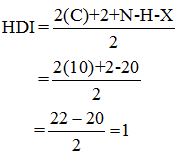
The HDI calculation led to confirm about the presence of a double bond or a ring.
Interpret the given 13CNMR spectrum:
Broadband - decoupled spectrum:
The spectrum shows six signals whereas the given molecular formula also has ten carbon atoms. Thus all the ten carbons have chemically different electronic environments showing signals.
i) The two signals in the region of 0-50ppm indicate the sp3 hybridized carbon atoms which can be methyl / methylene groups.
DEPT -90: Spectrum has signals led to confirmation of CH group in the structure.
DEPT -135 (gives signals of CH2, C, CH3 groups):
ii) The two positive signals indicate the presence of three methyl groups as no signals appear in the DEPT -90 spectrum.
iii) The three negative signals indicate the presence of five methylene groups; only methylene groups appear negative in the spectrum.
iv) So far the group of fragments obtained is
Two -CH3, -CH2
From the fragments (CH3)3 + (CH2)5 + CH + C = 20 protons) twenty protons are obtained whereas the total number of protons from the molecular formula is also twenty.
The structure of a given molecular formula C10H20 is predicted using 13CNMR spectra.
d)
Interpretation:
The structure of an given molecular formula C8H16 to be predicted using 13CNMR spectra.
Concept introduction:
The 13CNMR spectrum gives information on the different electronic environments of carbon. As like 1HNMR, the number of signals generated in 13CNMR are predicted by performing symmetry operations (rotation or reflection symmetry). Only chemical shift values are reported in the spectrum but not the multiplicity and integration values because the coupling between two neighboring 13C - 13C nuclei are weakly involved due to the low abundance of 13C isotopes of carbon atom.
Broadband-decoupled 13CNMR spectrum: The spectra provide information regarding the total number of carbon environments.
DEPT (Distortionless enhancement by polarization transfer):
i) DEPT -90: The spectrum exhibits signal only from CH group and no signals from CH3, CH2, CH and quaternary carbon (carbon with no protons).
ii) DEPT -135: The spectrum exhibits CH3 groups and CH groups as positive signals (pointing up); CH2 groups appear as negative signals (pointing down) and quaternary carbon does not appear.
The signals appear in each type of spectrum:

To identify:
The structure of given molecular formula C6H10.
Answer to Problem 47AP

Explanation of Solution
Calculate HDI:
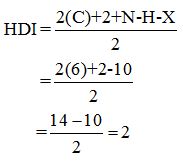
The HDI calculation led to confirm about the presence of a double bond or a ring. (two unsaturated degree).
Interpret the given 13CNMR spectrum:
Broadband - decoupled spectrum:
The spectrum shows six signals whereas the given molecular formula also has six carbon atoms. Thus all the six carbons have chemically different electronic environments showing signals.
i) The two signals in the region of 0-50ppm indicate the sp3 hybridized carbon atoms which can be methyl / methylene groups.
DEPT -90: Spectrum has signals led to confirmation of CH group in the structure.
DEPT -135 (gives signals of CH2, C, CH3 groups):
ii) The four positive signals indicate the presence of two methyl groups as no signals appear in the DEPT -90 spectrum.
iii) The negative signals indicate the presence of methylene groups; only methylene groups appear negative in the spectrum.
iv) So far the group of fragments obtained is
Two -CH3, -CH2
From the fragments (CH3)2 + CH2 + (CH)2 + C = 10 protons) ten protons are obtained whereas the total number of protons from the molecular formula is also ten.
The structure of a given molecular formula C6H10 is predicted using 13CNMR spectra.
e)
Interpretation:
The structure of an given molecular formula C8H16 to be predicted using 13CNMR spectra.
Concept introduction:
The 13CNMR spectrum gives information on the different electronic environments of carbon. As like 1HNMR, the number of signals generated in 13CNMR are predicted by performing symmetry operations (rotation or reflection symmetry). Only chemical shift values are reported in the spectrum but not the multiplicity and integration values because the coupling between two neighboring 13C - 13C nuclei are weakly involved due to the low abundance of 13C isotopes of carbon atom.
Broadband-decoupled 13CNMR spectrum: The spectra provide information regarding the total number of carbon environments.
DEPT (Distortionless enhancement by polarization transfer):
i) DEPT -90: The spectrum exhibits signal only from CH group and no signals from CH3, CH2, CH and quaternary carbon (carbon with no protons).
ii) DEPT -135: The spectrum exhibits CH3 groups and CH groups as positive signals (pointing up); CH2 groups appear as negative signals (pointing down) and quaternary carbon does not appear.
The signals appear in each type of spectrum:

To identify:
The structure of given molecular formula C8H16.
Answer to Problem 47AP
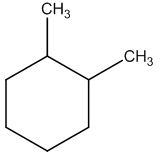
Explanation of Solution
Calculate HDI:
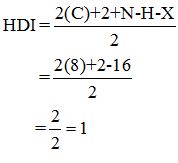
The HDI calculation led to confirm about the presence of a double bond or a ring.
Interpret the given 13CNMR spectrum:
Broadband - decoupled spectrum:
The spectrum shows four signals whereas the given molecular formula also has eight carbon atoms. Thus all the eight carbons have chemically different electronic environments showing signals.
i) The four signals in the region of 0-50ppm indicate the sp3 hybridized carbon atoms which can be methyl / methylene or Methine groups.
DEPT -90: Spectrum has no signals led to confirmation of CH group in the structure.
DEPT -135 (gives signals of CH2, CH3 and CH groups):
ii) The two positive signals indicate the presence of two methyl groups as no signals appear in the DEPT -90 spectrum.
iii) The two negative signals indicate the presence of four methylene groups; only methylene groups appear negative in the spectrum.
iv) So far the group of fragments obtained is
Two -CH3, -CH-, four -CH2
From the fragments (CH3 + CH3 + (CH2)4 + (CH)2 = 16 protons) sixteen protons are obtained whereas the total number of protons from the molecular formula is also sixteen.
The structure of a given molecular formula C8H16 is predicted using 13CNMR spectra.
f)
Interpretation:
The structure of an given molecular formula C8H16 to be predicted using 13CNMR spectra.
Concept introduction:
The 13CNMR spectrum gives information on the different electronic environments of carbon. As like 1HNMR, the number of signals generated in 13CNMR are predicted by performing symmetry operations (rotation or reflection symmetry). Only chemical shift values are reported in the spectrum but not the multiplicity and integration values because the coupling between two neighboring 13C - 13C nuclei are weakly involved due to the low abundance of 13C isotopes of carbon atom.
Broadband-decoupled 13CNMR spectrum: The spectra provide information regarding the total number of carbon environments.
DEPT (Distortionless enhancement by polarization transfer):
i) DEPT -90: The spectrum exhibits signal only from CH group and no signals from CH3, CH2, CH and quaternary carbon (carbon with no protons).
ii) DEPT -135: The spectrum exhibits CH3 groups and CH groups as positive signals (pointing up); CH2 groups appear as negative signals (pointing down) and quaternary carbon does not appear.
The signals appear in each type of spectrum:

To identify:
The structure of given molecular formula C6H10O.
Answer to Problem 47AP
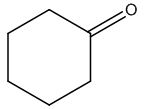
Explanation of Solution
Calculate HDI:
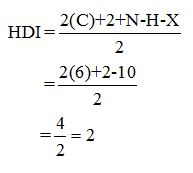
The HDI calculation led to confirm about the presence of a double bond or a ring.
Interpret the given 13CNMR spectrum:
Broadband - decoupled spectrum:
The spectrum shows four signals whereas the given molecular formula also has six carbon atoms. Thus all the six carbons have chemically different electronic environments showing signals.
i) The four signals in the region of 0-50ppm indicate the sp3 hybridized carbon atoms which can be methyl / methylene or Methine groups.
DEPT -135 (gives signals of CH2, C groups):
ii) The two negative signals indicate the presence of four methylene groups; only methylene groups appear negative in the spectrum.
iii) So far the group of fragments obtained is
C=O, -C-, four -ch2
From the fragments (CH2)5 + C = 10 protons) ten protons are obtained whereas the total number of protons from the molecular formula is also ten.
The structure of a given molecular formula C6H10O is predicted using 13CNMR spectra.
Want to see more full solutions like this?
Chapter 13 Solutions
Organic Chemistry
- Epoxides can be opened in aqueous acid or aqueous base to produce diols (molecules with two OH groups). In this question, you'll explore the mechanism of epoxide opening in aqueous acid. 2nd attempt Be sure to show all four bonds at stereocenters using hash and wedge lines. 0 0 Draw curved arrows to show how the epoxide reacts with hydronium ion. 100 +1: 1st attempt Feedback Be sure to show all four bonds at stereocenters using hash and wedge lines. See Periodic Table See Hint H A 5 F F Hr See Periodic Table See Hintarrow_forward03 Question (1 point) For the reaction below, draw both of the major organic products. Be sure to consider stereochemistry. > 1. CH₂CH₂MgBr 2. H₂O 3rd attempt Draw all four bonds at chiral centers. Draw all stereoisomers formed. Draw the structures here. e 130 AN H See Periodic Table See Hint P C Brarrow_forwardYou may wish to address the following issues in your response if they are pertinent to the reaction(s) you propose to employ:1) Chemoselectivity (why this functional group and not another?) 2) Regioselectivity (why here and not there?) 3) Stereoselectivity (why this stereoisomer?) 4) Changes in oxidation state. Please make it in detail and draw it out too in what step what happens. Thank you for helping me!arrow_forward
- 1) Chemoselectivity (why this functional group and not another?) 2) Regioselectivity (why here and not there?) 3) Stereoselectivity (why this stereoisomer?) 4) Changes in oxidation state. Everything in detail and draw out and write it.arrow_forwardCalculating the pH at equivalence of a titration 3/5 Izabella A chemist titrates 120.0 mL of a 0.7191M dimethylamine ((CH3)2NH) solution with 0.5501 M HBr solution at 25 °C. Calculate the pH at equivalence. The pk of dimethylamine is 3.27. Round your answer to 2 decimal places. Note for advanced students: you may assume the total volume of the solution equals the initial volume plus the volume of HBr solution added. pH = ☐ ✓ 18 Ar Boarrow_forwardAlcohols can be synthesized using an acid-catalyzed hydration of an alkene. An alkene is combined with aqueous acid (e.. sulfuric acid in water). The reaction mechanism typically involves a carbocation intermediate. > 3rd attempt 3343 10 8 Draw arrows to show the reaction between the alkene and hydronium ion. that 2nd attempt Feedback 1st attempt تعمال Ju See Periodic Table See Hint F D Ju See Periodic Table See Hintarrow_forward
- Draw the simplified curved arrow mechanism for the reaction of acetone and CHgLi to give the major product. 4th attempt Π Draw the simplified curved arrow mechanism T 3rd attempt Feedback Ju See Periodic Table See Hint H -H H -I H F See Periodic Table See Hintarrow_forwardSelect the correct reagent to accomplish the first step of this reaction. Then draw a mechanism on the Grignard reagent using curved arrow notation to show how it is converted to the final product. 4th attempt Part 1 (0.5 point) Select the correct reagent to accomplish the first step of this reaction. Choose one: OA Mg in ethanol (EtOH) OB. 2 Li in THF O C. Li in THF D. Mg in THF O E Mg in H2O Part 2 (0.5 point) Br Part 1 Bri Mg CH B CH, 1 Draw intermediate here, but no arrows. © TE See Periodic Table See Hint See Hint ין Harrow_forwardSelect the product for the following reaction. HO HO PCC OH ○ OH O HO ○ HO HO HOarrow_forward
- 5:45 Х Select the final product for the following reaction sequence. O O 1. Mg. ether 2.D.Oarrow_forwardBased on the chart Two similarities between the molecule with alpha glycosidic linkages. Two similarities between the molecules with beta glycosidtic linkages. Two differences between the alpha and beta glycosidic linkages.arrow_forwardplease help fill in the tablearrow_forward

 Organic ChemistryChemistryISBN:9781305580350Author:William H. Brown, Brent L. Iverson, Eric Anslyn, Christopher S. FootePublisher:Cengage Learning
Organic ChemistryChemistryISBN:9781305580350Author:William H. Brown, Brent L. Iverson, Eric Anslyn, Christopher S. FootePublisher:Cengage Learning

